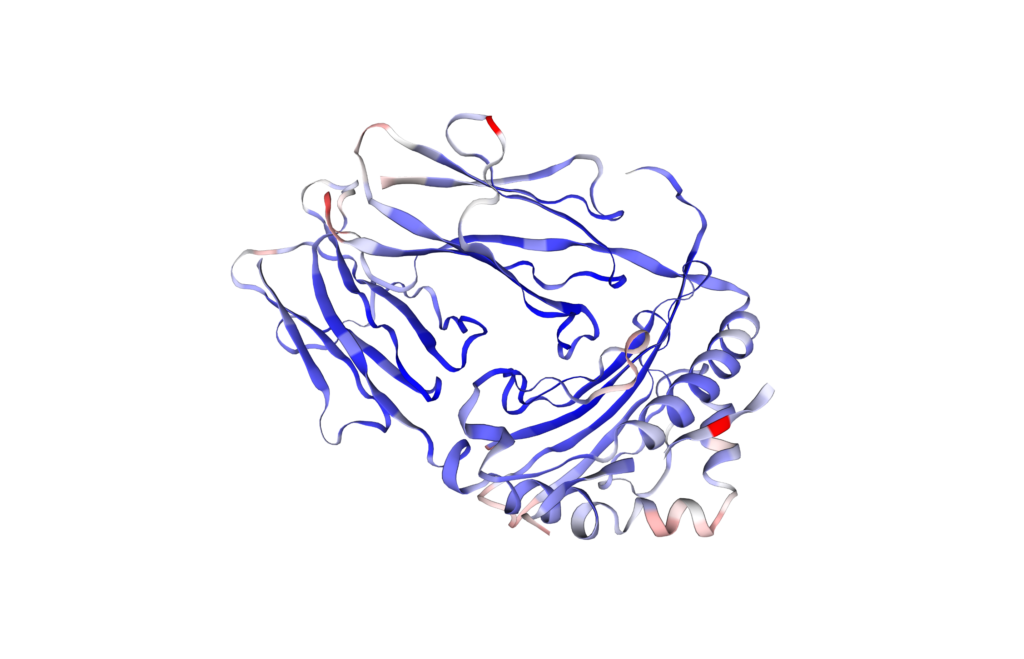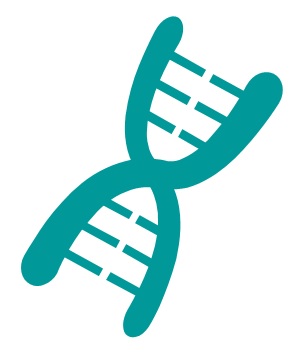Melan-A (26-35) A27L peptide (ELAGIGILTV) – Melanoma-Associated Antigen
Native Melan-A (26-35) decapeptide derives from the melanocyte lineage-specific protein Melan-A/MART-1 (UniProtKB – Q16655),which is expressed in almost 75-100% of primary and metastatic melanomas.
Melan-A/MART-1 protein
Melan-A,also known as melanoma antigen,recognized by T-cells 1 (Th1) or MART-1 cells,is a 118 amino acids (AA) type III transmembrane protein,consisting in a 26 AA extracellular region (AA 1-26) and a 71 AA cytoplasmic domain.

The latter is only expressed on the surface of melanocytes,melanoma,and retinal pigment epithelium cells,but not in other normal tissues. This unique feature is used in anatomic pathology for melanocytic differentiation that is useful to diagnose melanomas.
The latter is found in the Golgi apparatus but the inversion of its membrane topology leads to its retention in the endoplasmic reticulum (ER). Human Melan-A is involved in melanosome biogenesis by maintaining the stability of GPR143 and its vital role in the functioning of glycoprotein-100 (gp100),also known as the melanocyte protein (PMEL),which is a critical player in the formation of stage II melanosomes.
Melan-A (26-35) antigenic peptide
The region 26-35 of Melan-A protein acts as an antigenic peptide that is recognized by CD8+ tumor-reactive cytolytic T lymphocytes (CTLs) for designing antigen-specific cancer vaccines. It has been shown that CD8+ Melan-A-specific CTLs isolated from melanoma patients efficiently lyse the Melan-A-expressing HLA-A*0201 melanoma cell line. However,CTLs preferentially recognize the Melan-A (26-35) peptide as compared with the Melan-A (27-35) peptide.
Later,Melan-A (26-35) A27L analog (ELAGIGILTV) emerged as an even more promising lead to target melanomas. The latter has a higher binding affinity to HLA-A*0201 than the native Melan-A (26-35) peptide (EAAGIGILTV) and consequently displays more potent antigenicity and immunogenicity.
It has been reported that the concentration of Melan-A (26-35) A27L analog required to obtain 50% of maximal antigenic activity is EC50 = 0.01 nM,whereas that of the native Melan-A (26-35) peptide is 0.25 nM. Therefore,the relative activity of Melan-A (26-35) A27L analog is 25 times higher than that of the native Melan-A (26-35) peptide.
Furthermore,functional competition assay has shown that the concentration of Melan-A (26-35) A27L analog required to achieve 50% inhibition of tumor lysis is IC50 = 2 nM,which is 10 times lower than that of the native Melan-A (26-35) peptide. Regarding peptide stability in human serum,the half-lives (t1/2) of the native Melan-A (26-35) peptide and the A27L analog are quite similar (45 and 40 min,respectively),as measured by HPLC-ESI-MS,but much higher than that of the Melan-A (27-35) nonapeptide (5 min).
SB-PEPTIDE also offers the native version of Melan-A (26-35) peptide,as well as its scrambled version (see sections « Melan-A (26-35) peptide » & « Melan-A (26-35) scrambled »).
Technical specifications
 |
Sequence : ELAGIGILTV |
 |
MW : 985.18 g/mol (C45H80N10O14) |
 |
Purity : > 95% |
 |
Counter-Ion : TFA Salts (see option TFA removal) |
 |
Delivery format : Freeze dried in propylene 2mL microtubes |
 |
Peptide Solubility Guideline |
 |
Bulk peptide quantities available |
Price
| Product catalog | Size | Price € HT | Price $ USD |
| SB279-1MG | 1 mg | 61 | 76 |
| SB279-5MG | 5 mg | 209 | 261 |
| SB279-2*5MG | 2×5 mg | 297 | 371 |
| SB279-5*10MG | 5×10 mg | 561 | 701 |
References
Frontiers. 2022 Apr 12;9:873777. doi: https://doi.org/10.3389/fmolb.2022.873777
The Many Faces of G Protein-Coupled Receptor 143,an Atypical Intracellular Receptor
GPCRs transform extracellular stimuli into a physiological response by activating an intracellular signaling cascade initiated via binding to G proteins. Orphan G protein-coupled receptors (GPCRs) hold the potential to pave the way for development of new , innovative therapeutic strategies. In this review we will introduce G protein- coupled receptor 143 (GPR143),an enigmatic receptor in terms of classification within the GPCR superfamily and localization. GPR143 has not been assigned to any of the GPCR families due to the lack of common structural motifs. Hence we will describe the most important motifs of classes A and B and compare them to the protein sequence of GPR143. While a precise function for the receptor has yet to be determined,the protein is expressed abundantly in pigment producing cells. Many GPR143 mutations cause X-linked Ocular Albinism Type 1 (OA1 , Nettleship-Falls OA) , which results in hypopigmentation of the eyes and loss of visual acuity due to disrupted visual system development and function. In pigment cells of the skin,loss of functional GPR143 results in abnormally large melanosomes (organelles in which pigment is produced). Studies have shown that the receptor is localized internally,including at the melanosomal membrane,where it may function to regulate melanosome size and/or facilitate protein trafficking to the melanosome through the endolysosomal system. Numerous additional roles have been proposed for GPR143 in determining cancer predisposition,regulation of blood pressure,development of macular degeneration and signaling in the brain,which we will briefly describe as well as potential ligands that have been identified. Furthermore,GPR143 is a promiscuous receptor that has been shown to interact with multiple other melanosomal proteins and GPCRs,which strongly suggests that this orphan receptor is likely involved in many different physiological actions.
J Clin Invest. 2005 Mar;115(3):739-746. https://doi.org/10.1172/JCI23373
Rapid and strong human CD8+ T cell responses to vaccination with peptide,IFA,and CpG oligodeoxynucleotide 7909
The induction of potent CD8+ T cell responses by vaccines to fight microbes or tumors remains a major challenge,as many candidates for human vaccines have proved to be poorly immunogenic. Deoxycytidyl-deoxyguanosin oligodeoxynucleotides (CpG ODNs) trigger Toll-like receptor 9,resulting in dendritic cell maturation that can enhance immunogenicity of peptide-based vaccines in mice. We tested whether a synthetic ODN,CpG 7909,could improve human tumor antigen–specific CD8+ T cell responses. Eight HLA-A2+ melanoma patients received 4 monthly vaccinations of low-dose CpG 7909 mixed with melanoma antigen A (Melan-A; identical to MART-1) analog peptide and incomplete Freund’s adjuvant. All patients exhibited rapid and strong antigen-specific T cell responses: the frequency of Melan-A–specific T cells reached over 3% of circulating CD8+ T cells. This was one order of magnitude higher than the frequency seen in 8 control patients treated similarly but without CpG and 1–3 orders of magnitude higher than that seen in previous studies with synthetic vaccines. The enhanced T cell populations consisted primarily of effector memory cells,which in part secreted IFN-γ and expressed granzyme B and perforin ex vivo. In vitro,T cell clones recognized and killed melanoma cells in an antigen-specific manner. Thus,CpG 7909 is an efficient vaccine adjuvant that promotes strong antigen-specific CD8+ T cell responses in humans.
J Immunol. 2001 Nov 15;167(10):5852-61. doi: 10.4049/jimmunol.167.10.5852
A new generation of Melan-A/MART-1 peptides that fulfill both increased immunogenicity and high resistance to biodegradation: implication for molecular anti-melanoma immunotherapy
Intense efforts of research are made for developing antitumor vaccines that stimulate T cell-mediated immunity. Tumor cells specifically express at their surfaces antigenic peptides presented by MHC class I and recognized by CTL. Tumor antigenic peptides hold promise for the development of novel cancer immunotherapies. However,peptide-based vaccines face two major limitations: the weak immunogenicity of tumor Ags and their low metabolic stability in biological fluids. These two hurdles,for which separate solutions exist,must,however,be solved simultaneously for developing improved vaccines. Unfortunately,attempts made to combine increased immunogenicity and stability of tumor Ags have failed until now. Here we report the successful design of synthetic derivatives of the human tumor Ag Melan-A/MART-1 that combine for the first time both higher immunogenicity and high peptidase resistance. A series of 36 nonnatural peptide derivatives was rationally designed on the basis of knowledge of the mechanism of degradation of Melan-A peptides in human serum and synthesized. Eight of them were efficiently protected against proteolysis and retained the antigenic properties of the parental peptide. Three of the eight analogs were twice as potent as the parental peptide in stimulating in vitro Melan-specific CTL responses in PBMC from normal donors. We isolated these CTL by tetramer-guided cell sorting and expanded them in vitro. The resulting CTL efficiently lysed tumor cells expressing Melan-A Ag. These Melan-A/MART-1 Ag derivatives should be considered as a new generation of potential immunogens in the development of molecular anti-melanoma vaccines.
JBC. 2001 Sept 10;276(46):43189-43196. doi: 10.1074/jbc.M103221200
Subcellular Localization of the Melanoma-associated Protein Melan-AMART-1 Influences the Processing of Its HLA-A2-restricted Epitope
The peptide derived from the melanoma-associated protein Melan-A (Melan-A26 –35/HLA-A2) is an attractive candidate for tumor immunotherapy but little is known about the intracellular processing of this antigen. Here we show that Melan-A is a single-pass membrane protein with an NH2 terminus exposed to the lumen of the exocytic compartment. In transfected melanoma cells,Melan-A accumulates in the Golgi region. Inversion of the membrane topology leads to the retention of Melan-A in the endoplasmic reticulum. Most strikingly,melanoma cells expressing this form of Melan-A are more effectively recognized by specific CTL than those expressing either Melan-A in its native membrane orientation or Melan-A artificially localized in the cytosol. Our data are compatible with the notion that proteins retained in the endoplasmic reticulum are more efficiently degraded and produce more antigenic peptides.
J Immunol. 1998 Feb 15;160(4):1750–1758. doi: https://doi.org/10.4049/jimmunol.160.4.1750
Enhanced Generation of Specific Tumor-Reactive CTL In Vitro by Selected Melan-A/MART-1 Immunodominant Peptide Analogues
The Melan-A/MART-1 gene,which is expressed by normal melanocytes as well as by most fresh melanoma samples and melanoma cell lines,codes for Ags recognized by tumor-reactive CTL. HLA-A*0201-restricted Melan-A-specific CTL recognize primarily the Melan-A27-35 (AAGIGILTV) and the Melan-A26-35 (EAAGIGILTV) peptides. The sequences of these two peptides are not necessarily optimal as far as binding to HLA-A*0201 is concerned,since both lack one of the dominant anchor amino acid residues (leucine or methionine) at position 2. In this study we introduced single amino acid substitutions in either one of the two natural peptide sequences with the aim of improving peptide binding to HLA-A*0201 and/or recognition by specific CTL. Surprisingly,analogues of the Melan-A27-35 peptide,which bound more efficiently than the natural nonapeptide to HLA-A*0201,were poorly recognized by tumor-reactive CTL. In contrast,among the Melan-A26-35 peptide analogues tested,the peptide ELAGIGILTV was not only able to display stable binding to HLA-A2.1 but was also recognized more efficiently than the natural peptide by two short-term cultured tumor-infiltrated lymph node cell cultures as well as by five of five tumor-reactive CTL clones. Moreover,in vitro generation of tumor-reactive CTL by stimulation of PBMC from HLA-A*0201 melanoma patients with this particular peptide analogue was much more efficient than that observed with either one of the two natural peptides. These results suggest that the Melan-A26-35 peptide analogue ELAGIGILTV may be more immunogenic than the natural peptides in HLA-A*0201 melanoma patients and should thus be considered as a candidate for future peptide-based vaccine trials.
